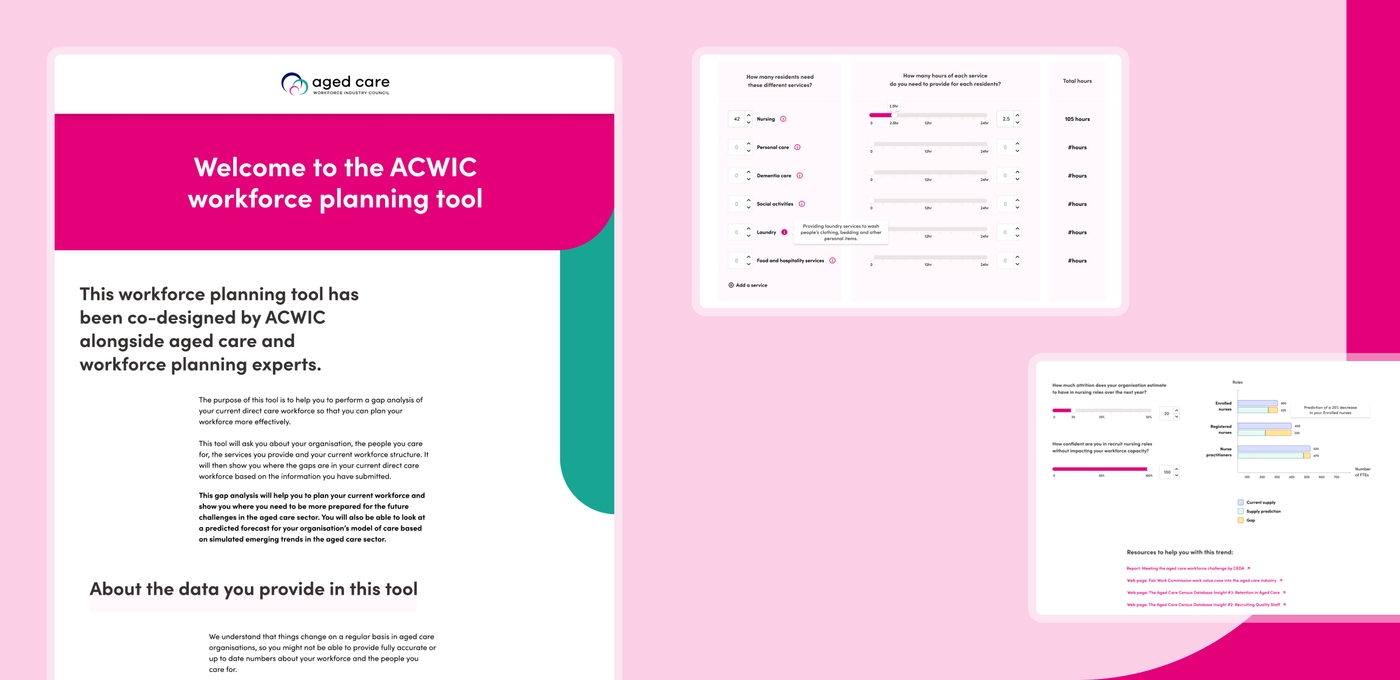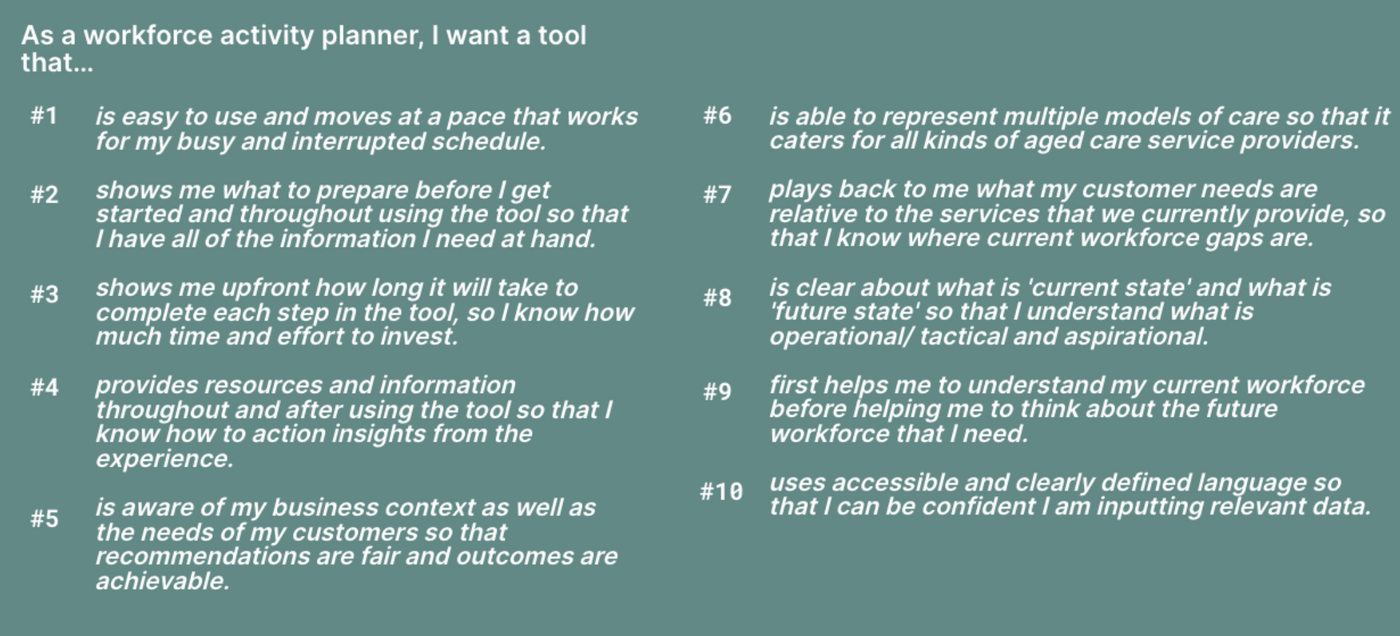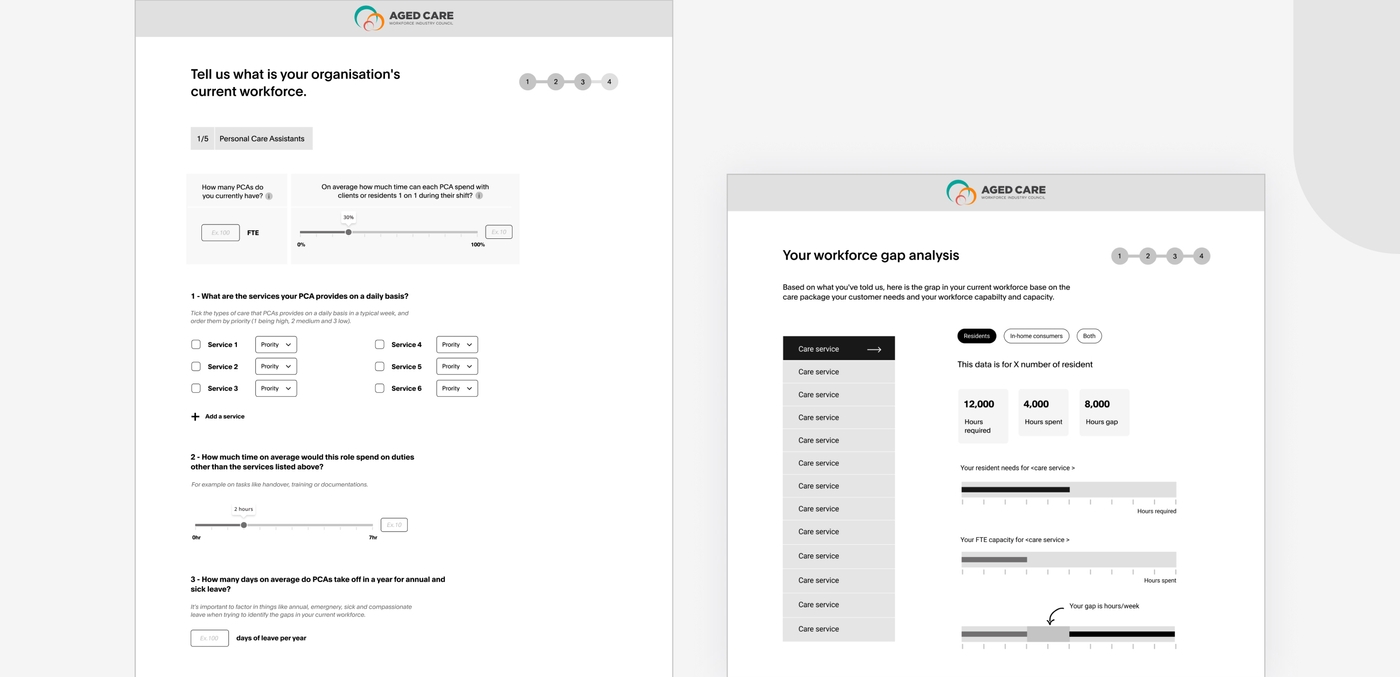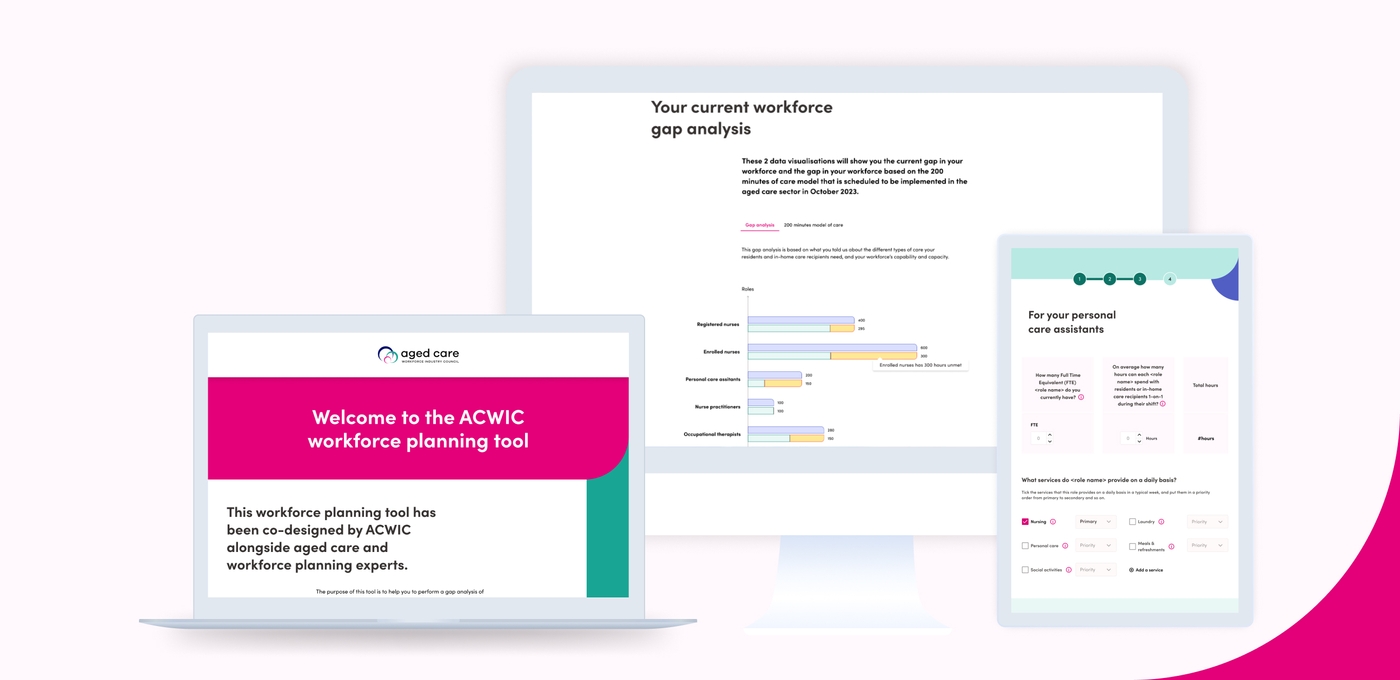Aged care workers currently care for more than 1.3 million Australians, both in home and residential settings, according to a CEDA Duty of care report. Demand for these workers is rapidly increasing due to demographic changes, increases to minimum aged care staffing levels and new funding to address unmet demand. These present significant challenges for aged care organisations in planning their workforce needs.
In 2018 the Department of Health released the Matter of Care report. This report outlined 14 recommendations to support Australia’s aged care workforce. The Aged Care Workforce Industry Council (ACWIC) was established to coordinate the implementation of the recommendations. We worked with ACWIC to implement one of these recommendations – to establish a digital tool for workforce planning.
Design challenge
Aged care organisations are required to demonstrate that their workforce is planned, and that both the number and mix of staff can manage and deliver safe, quality care and services. Because of this, a standard approach to the fundamental elements of workforce planning was essential.
Thanks to a broad range of research from governments agencies and aged care organisations, the problems surrounding aged care workforce planning were clearly understood. Though the specifics on the kind of support that the sector needed from a workforce planning tool still needed to be defined.
We took a human-centred design approach to work through this ambiguity with ACWIC, the Department of Health, the aged care sector and workforce planning experts, in order to develop a solution that was practical.

The need for a skills mix model for aged care
Aged care organisations need to build and adjust their workforce to support innovation through different models of care, or to enable specific care interventions according to service demand. As part of the project we delivered a skills mix model to identify the competencies, composition and workloads in aged care organisations.
Approach
Our tried, tested and refined approach to human-centred design allowed us to rapidly deliver prototypes, research insights, and digital products that placed user needs at the centre. From the very beginning of this project we worked closely with a range of key stakeholders – the Aged Care Workforce Industry Council, the Department of Health, a workforce planning expert from Deliberatedge, a working group and a steering committee with representatives from diverse aged care organisations.
1. Exploring the problems through needs-based interviews
We conducted individual exploratory interviews with 24 aged care professionals to understand their needs, expectations and barriers to achieving optimal workforce planning in the aged care sector. This helped us to understand who exactly this workforce planning tool should be for, and what goals it could help them to achieve.
This informed 10 guiding principles that would steer us throughout the rest of this project.

2. Defining the problem through validation with Aged Care Providers
Following this, we collaborated with ACWIC to develop some initial concepts for the skills mix model, content design and logic of the interactive workforce planning tool. We produced these in a low-fidelity, sketch format to allow us to iterate and reform the concepts as we progressed.
We then shared these initial concepts with aged care providers in order to validate our understanding of the problem and gather useful feedback about which parts would provide value to their workforce planning activities.
3. Mapping the content logic
With a clear and solid understanding of what the workforce planning tool needed to include, we began to develop more detailed content logic mapping.
Our content strategist collaborated with our design strategists to map out the complex content logic for the tool, including the questions that would help to build a picture of an aged care organisation’s workforce. The content logic also took into account the diverse job roles, responsibilities and obligations in the aged care sector. Additionally, it helps aged care providers to forecast the requirements to meet an average of 200 minutes per resident per day, based on care provided by registered nurses, enrolled nurses and personal care workers due to be introduced in Australia in the future.
Once the content logic was mapped out, we refined it further with ACWIC. This enabled us to ensure that the tool would ask the right questions, at the right time, in a logical order so that workforce planners could see the value in using the tool.
In the final stages of the content logic mapping, we clearly defined what an aged care provider would see once they had completed the tool. This included an outline of their current workforce, a prediction of the future workforce needed, an explanation of the gap between the two, and how an aged care organisation could close the gap.

4. Prototyping, iteration and design
Following this, we moved into prototyping. Our content strategist and experience designer collaborated closely to take the content logic and translate it into wireframes, to share and validate with ACWIC and members of the working group.
As we gathered more feedback and insights the wireframes developed from low fidelity outlines, to high fidelity prototypes. We validated the workforce planning tool’s design direction with aged care providers regularly, occasionally revisiting the content logic as we uncovered new needs or challenges. This comprehensive design and prototyping phase enabled us to rigorously explore the feasibility and functionality of every stage and feature of the tool. This was reviewed by aged care experts and professionals to ensure that the tool was valuable and accessible for both.
Portable’s designers and developers also collaborated during this phase, to ensure that the design components would work with the build of the website. This allowed for a smooth transition during the final development phase.
5. Technical solution design
We defined the technical objectives of the tool, including the need for it to be freely available to the sector, the ability to create an account and save one’s progress, and to be easily accessible for different levels of digital literacy. We also understood that ACWIC would need a content management system that they could easily update to ensure references to key resources, which could remain current and up-to-date.
From here we defined the technical and user requirements for the workforce planning tool and selected the appropriate technical stack for the build. From here, we facilitated a workshop with the ACWIC to prioritise features and user stories. This ensured that our scope for development was aligned with their expectations and those of the working group.
6. Development, testing and go live
We conducted targeted user testing sessions on the data model and calculations that would drive the key outputs of the tool with several aged care providers prior to the build. This helped us to further ensure that the tool would output data that would provide practical use by the people who used it.
The design and development teams documented acceptance criteria to accompany the designs, in order to ensure that the development phase was as smooth as possible. The acceptance criteria determined the scope and requirements to be executed by developers during the build.
The development phase was a highly concentrated part of the project - with the team building, testing and completing user acceptance testing with the Aged Care Workforce Industry Council in just 9 weeks. During this time we showcased our progress to ACWIC and the broader group of stakeholders, as well as some of the co-design participants from earlier stages, and we iterated some elements of the tool based on their feedback.

Outcomes
ACWIC’s workforce planning tool provides a free and standardised approach to workforce planning for aged care organisations of any size or maturity in Australia. The tool is supported by clear and accessible descriptions and definitions, as well as reliable resources to help workforce planners to feel confident in their approach.
The tool also allows aged care providers to return to their progress at any time, and access data visualisations and explanations of their current workforce, the predicted workforce gap and any suggested actions. Each aged care provider also has access to a downloadable report that includes data captured about their workforce, in a format that can easily be shared within their organisation and used to track changes to their workforce over time.
This workforce planning tool is being implemented throughout Australia, providing free and useful services for aged care providers. The Aged Care Workforce Industry Council will be working closely with providers to help embed the tool in their workforce planning processes, and collect feedback on what is working well, and areas that may need to be enhanced or improved.
Reflections
Emily Pearce, Senior Content Strategist
"Because of the diversity of aged care organisations, the tool’s content logic needed to be consistent enough so that it was easy to follow but also flexible enough to enable any aged care organisation to fill it in accurately."
Project team
Sarah Kaur - Business Design Specialist
Aishling Costello - Senior Design Strategist
Emily Pearce - Senior Content Strategist
Lucie Cleuet - Senior Experience Designer
Alice Reeve - Senior Digital Producer
Lauren Manning - Senior Digital Producer
Naomi Wilson - Senior Account Manager
Andy Kilham - Senior Developer
Deb Cupitt - Mid-level Developer
Andrew Fulton - Lead Developer
Chris D’Aloisio - Head of Technology
Jeffrey Basilio - Quality Assurance
Bryan Angelo Maniaui - Quality Assurance